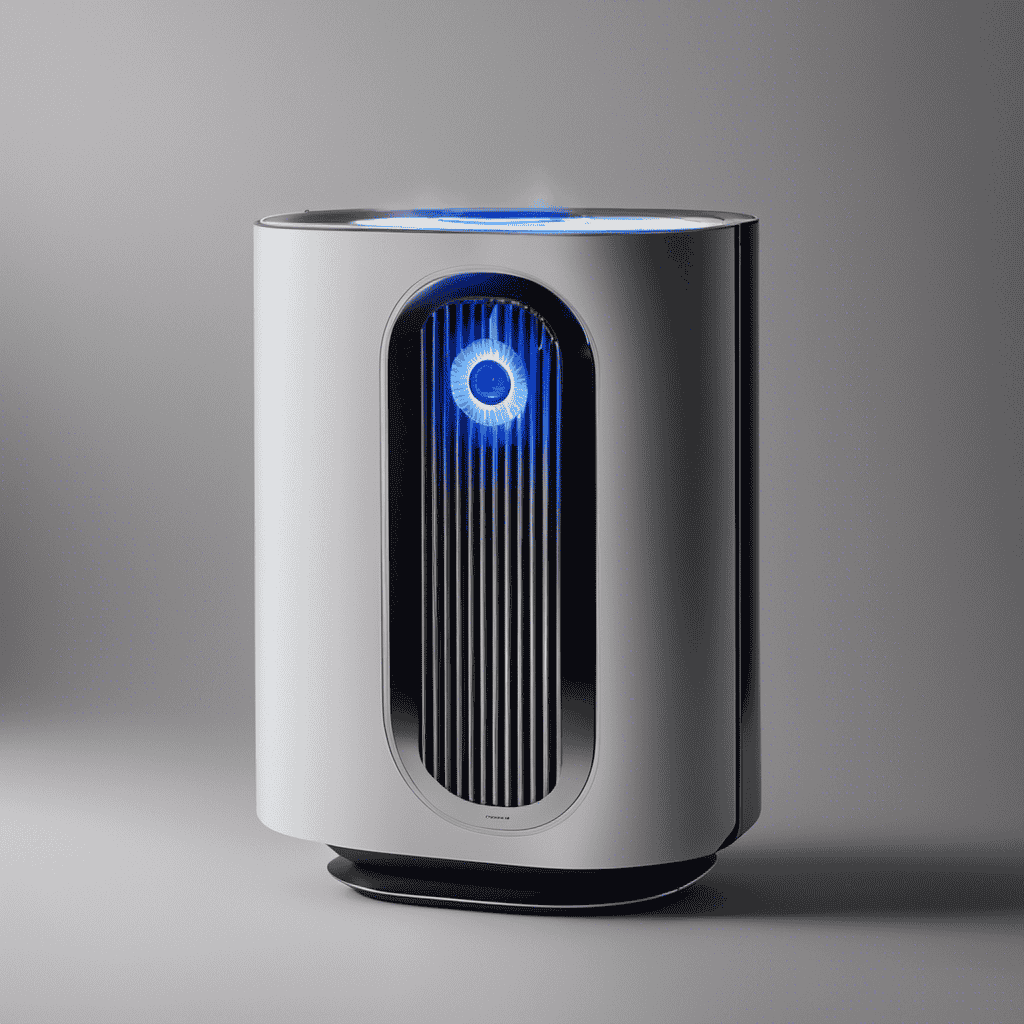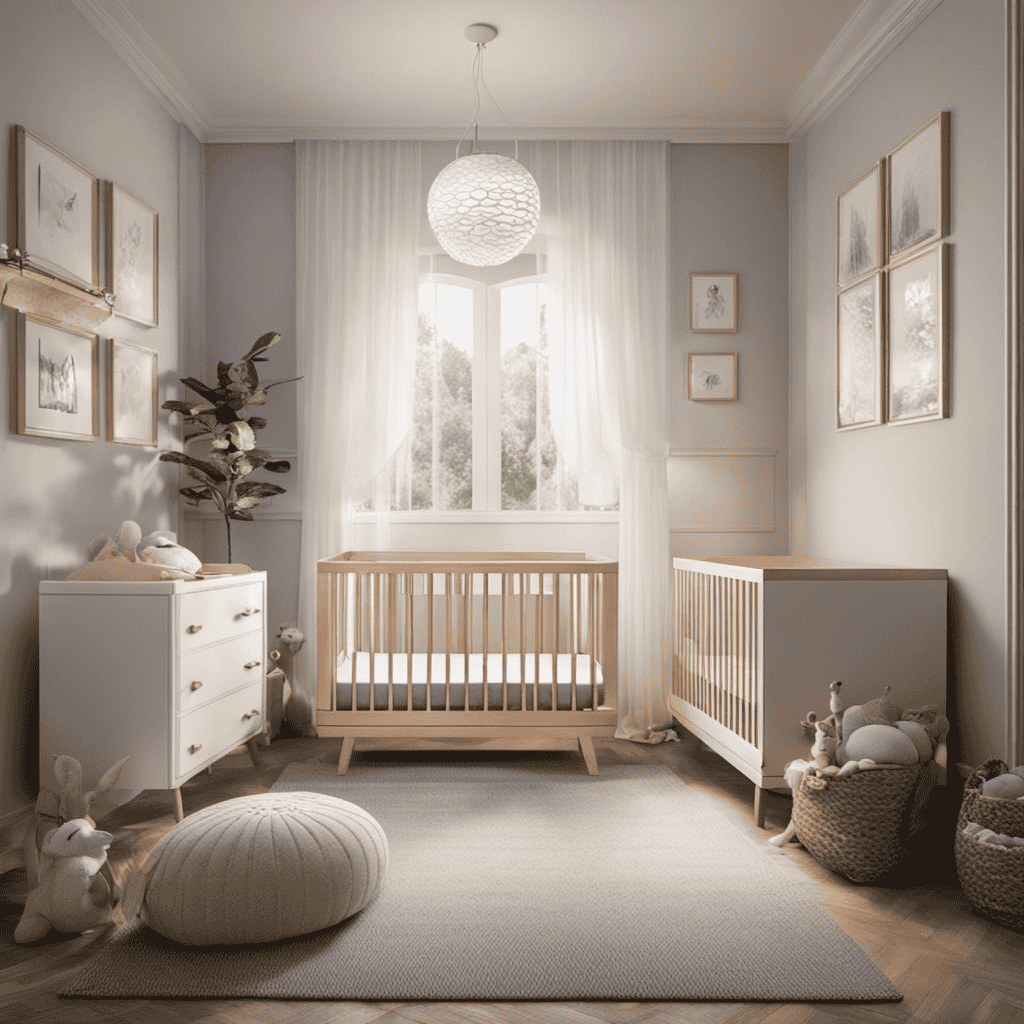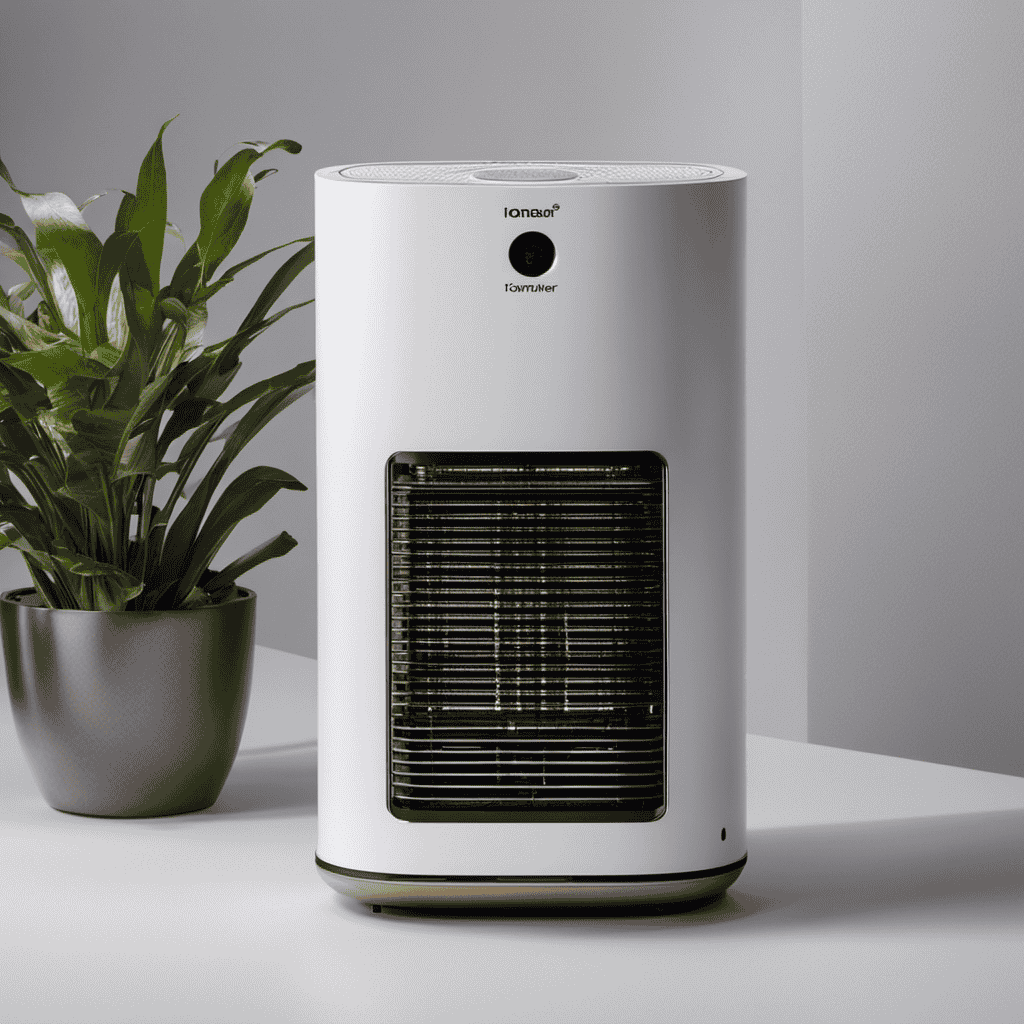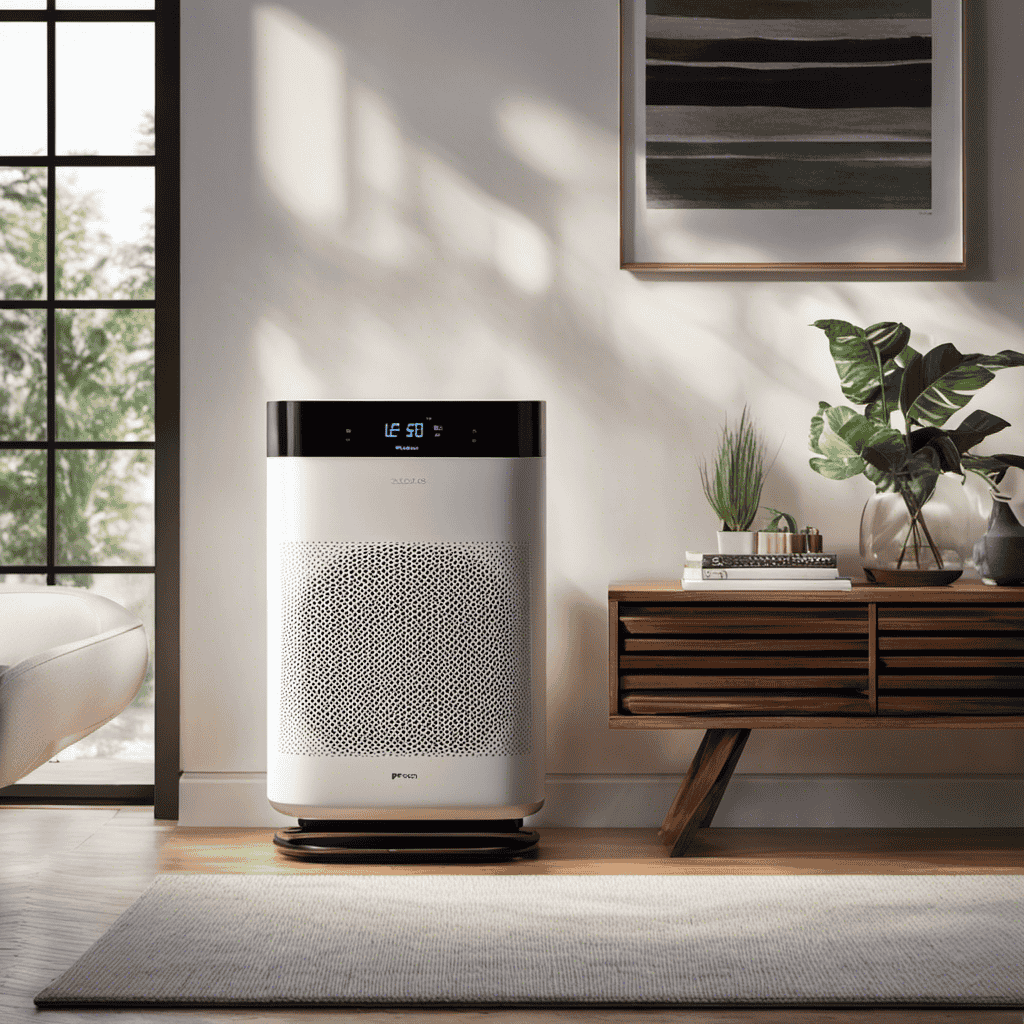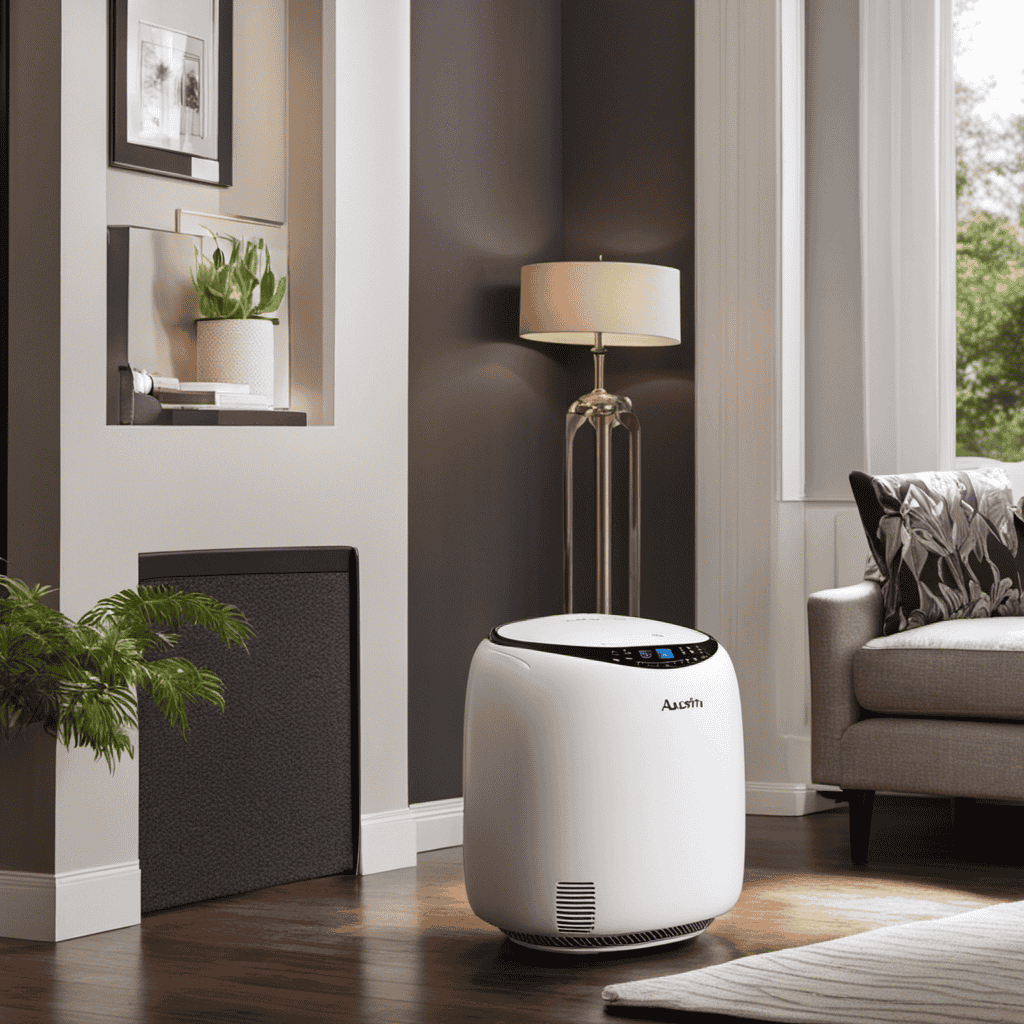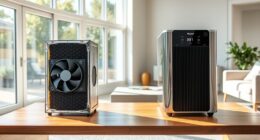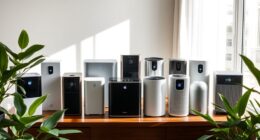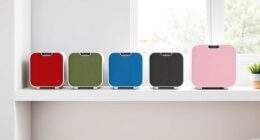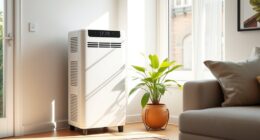While seated in my house, inhaling what appears to be fresh air, I can’t help but ponder about the activities happening within my air purifier.
What does the ionizer do? Well, let me tell you, it’s a fascinating process.
The ionizer, with its active and purifying powers, works to eliminate pollutants from the air, leaving behind nothing but fresh, clean oxygen.
So, join me on this scientific journey as we uncover the mysteries of the ionizer in air purifiers.
Key Takeaways
- Ionizers use charged particles to neutralize pollutants in the air.
- They effectively remove pollutants, reducing the risk of respiratory issues and allergies.
- Ionizers help eliminate odors by neutralizing charged particles responsible for unpleasant smells.
- Ionizers release charged ions into the air, improving air quality by reducing harmful particles.
How Does an Ionizer Work
An ionizer uses charged particles to neutralize pollutants in the air, improving air quality. Ionizer technology works by emitting negatively charged ions into the air. These ions attach themselves to positively charged particles, such as dust, pollen, and smoke, causing them to become heavier and fall to the ground or stick to surfaces.
This process, known as ionization, effectively removes these pollutants from the air, reducing the risk of respiratory issues and allergies. Additionally, ionizers can help eliminate odors by neutralizing the charged particles responsible for unpleasant smells.
The benefits of using an ionizer in an air purifier include fresher and cleaner air, reduced allergens and irritants, and improved overall indoor air quality.
Understanding Ionization in Air Purifiers
To understand how ionization works in air purifiers, you’ll want to know that it helps remove harmful particles from the air you breathe.
The ionization process involves the generation of negative ions, which are electrically charged particles. These negative ions are released into the air by the air purifier and attach themselves to airborne particles, such as dust, pollen, and smoke.
When the negative ions bond with these particles, they become heavier and fall to the ground or onto nearby surfaces. This process effectively removes these particles from the air, improving the overall air quality in the room.
Additionally, negative ions have been found to have a positive impact on our health, as they can help boost mood, increase energy levels, and reduce stress.
The Role of Ions in Air Purification
When it comes to air purification, one key component to consider is the ionizer. The ionizer is responsible for releasing charged ions into the air, which help to remove pollutants and improve overall air quality.
The benefits of ionization include reducing allergens, neutralizing odors, and eliminating harmful bacteria and viruses in the air.
Ionizer and Air Purification
You’ll notice that the ionizer on your air purifier helps to improve air quality by removing harmful particles. Understanding the mechanism behind the ionizer can help you maintain its efficiency.
The ionizer emits negative ions, which attach themselves to airborne particles, making them heavier and causing them to fall to the ground or be captured by the air purifier’s filters.
To keep your ionizer working effectively, follow these maintenance tips:
- Clean the ionizer regularly to remove any buildup of particles.
- Check the ionizer plates for dirt or residue and clean them if necessary.
- Replace the ionizer plates according to the manufacturer’s recommendations.
- Keep the air purifier in a well-ventilated area to ensure proper ionization.
By properly maintaining your ionizer, you can ensure that it continues to effectively remove harmful particles from your indoor air.
Now, let’s explore the benefits of ionization in the next section.
Benefits of Ionization
One of the benefits of ionization is that it can improve the overall air quality in your home. When an ionizer is used in an air purifier, it releases negative ions into the air. These negative ions attach themselves to airborne particles, such as dust, pollen, and pet dander, causing them to become heavy and fall to the ground. This helps to reduce the number of harmful particles floating in the air, making it cleaner and healthier to breathe.
Additionally, negative ions have been found to have a positive effect on our overall well-being. They can boost mood, increase energy levels, and even improve sleep quality. With the help of ionization, you can enjoy cleaner air and a more pleasant living environment.
Benefits of Using an Ionizer in Your Air Purifier
When it comes to improving air quality, using an ionizer in your air purifier can be highly beneficial.
Not only does it help to remove harmful particles from the air, but it also has the capability to reduce unpleasant odors.
Additionally, an ionizer can effectively eliminate allergens, making it a valuable tool for those with allergies or respiratory issues.
Air Quality Improvement
To improve the air quality in your home, the ionizer on your air purifier releases negatively charged ions that attract and neutralize airborne particles. This process helps to eliminate pollutants such as dust, pollen, pet dander, and mold spores, making the air cleaner and healthier to breathe.
Maintaining your air purifier and its ionizer is crucial to ensure its effectiveness in improving air quality. Regular cleaning and filter replacement are essential to keep the device running efficiently. Neglecting air purifier maintenance can result in decreased performance and compromised air quality.
It is important to remember that clean air is vital for our overall health and well-being. Breathing in clean air can reduce the risk of respiratory problems, allergies, and other health issues.
By properly maintaining your air purifier and utilizing its ionizer function, you can create a healthier indoor environment for you and your loved ones.
-
Benefits of using an ionizer in your air purifier:
-
Eliminates airborne particles such as dust, pollen, pet dander, and mold spores
-
Improves air quality and reduces the risk of respiratory problems
-
Importance of clean air:
-
Reduces the risk of allergies and other health issues
-
Creates a healthier indoor environment for you and your family
Odor Reduction Capabilities
The ionizer in an air purifier can help reduce unpleasant odors by neutralizing airborne particles. When the air passes through the ionizer, it releases negatively charged ions that attach to positively charged particles, such as dust, pollen, and bacteria. This process causes the particles to become heavier and fall to the ground or stick to surfaces, effectively removing them from the air.
To ensure the efficiency of the ionizer, regular air purifier maintenance is crucial. Cleaning or replacing the ionizer plates or filters, as recommended by the manufacturer, will help maintain optimal performance.
Additionally, when choosing the right air purifier, consider the size of the room where it will be placed and the specific odor reduction needs. Some air purifiers have specialized odor filters or additional features, such as activated carbon, which can further enhance odor reduction capabilities.
Allergen Elimination Effectiveness
Regular maintenance is essential for optimal performance of an air purifier in eliminating allergens. The ionizer, a key component of many air purifiers, plays a crucial role in improving the overall effectiveness of the device.
Here are some important points to consider regarding the ionizer’s impact on respiratory health and its effectiveness in eliminating allergens:
- The ionizer releases negatively charged ions into the air, which attach to airborne particles and allergens.
- These charged particles become too heavy to remain in the air and eventually settle on surfaces or get trapped in the purifier’s filters.
- The ionizer’s ability to eliminate allergens is highly dependent on the air purifier’s overall design, including the strength of the ionizer and the efficiency of the filtration system.
- Regular cleaning and maintenance of the ionizer, such as wiping it down and replacing filters as recommended, are crucial for optimal performance and allergen elimination.
- When used correctly, an air purifier with an ionizer can significantly reduce allergens in the air, leading to improved respiratory health for individuals with allergies or asthma.
Can Ionizers Remove Pollutants From the Air
Ionizers can help remove pollutants from the air by releasing negatively charged ions that attach to particles and make them heavy enough to fall out of the air. These ions essentially neutralize the pollutants, such as dust, pollen, and smoke, by binding to them and causing them to lose their charge. This process is known as ionization.
When the particles become heavy, they are no longer suspended in the air and can easily settle on surfaces or be removed through regular cleaning. This can significantly improve respiratory health by reducing the number of irritants and allergens present in the air.
Additionally, ionizers are effective in removing pet dander, a common allergen, from the air. The negatively charged ions emitted by the ionizer attract the positively charged pet dander, causing it to clump together and eventually fall out of the air.
Ionization Vs Filtration: Which Is Better for Air Purification
One option for air purification is using ionization. This method effectively removes smaller particles such as smoke and allergens. It can also neutralize certain types of bacteria and viruses. However, ionization has its drawbacks. Ozone production can be harmful to human health, and it may not be as effective in removing larger particles like dust and pet dander.
Another option is filtration, specifically using HEPA filters. Filtration is highly effective in removing a wide range of particles, including allergens, dust, and pet dander. Unlike ionization, filtration does not produce harmful byproducts like ozone. However, filtration may not be as effective in removing smaller particles like smoke and certain types of bacteria.
How Effective Are Ionizers at Eliminating Odors
When it comes to eliminating odors, the role of an ionizer in an air purifier is significant. Ionizers work by releasing negatively charged ions into the air, which attach themselves to positively charged particles like dust, pollen, and odor molecules.
These charged particles then become heavy and fall to the ground or get trapped in a filter, resulting in reduced odors in the air. However, the effectiveness of ionizers in odor removal may vary depending on factors such as the size and concentration of odor molecules and the strength of the ionizer.
Odor Elimination: Ionizer’s Role
The ionizer’s role in my air purifier is to help eliminate odors. It achieves this by releasing negatively charged ions into the air, which attach themselves to positively charged particles, such as dust, pollen, and smoke. This neutralizes the particles and makes them too heavy to remain airborne, causing them to fall to the ground or get trapped in the air purifier’s filters.
To fully enjoy the benefits of an ionizer and ensure safety, it is important to follow certain precautions:
- Place the air purifier in a well-ventilated area, away from walls and furniture, to allow proper circulation of air.
- Regularly clean and maintain the air purifier, including the ionizer, to prevent the accumulation of dirt and dust on the unit.
- Clean the ionizer plates or emitter wires as per the manufacturer’s instructions to maintain optimal performance.
- Keep the ionizer away from water or moisture to avoid electrical hazards.
Ionizers: Odor Removal Efficacy?
To fully understand the efficacy of odor removal, it is important to consider the role of ionizers in air purifiers. Ionizers play a crucial role in improving indoor air quality by reducing airborne particles and contaminants. These devices work by releasing negatively charged ions into the air, which attach themselves to positively charged particles such as dust, pollen, and even odorous molecules. This process causes the particles to become heavy and fall to the ground, effectively removing them from the air we breathe.
Ionizers have been found to have a positive impact on respiratory health. By reducing the number of airborne particles, they can help alleviate symptoms of allergies, asthma, and other respiratory conditions. Additionally, studies have shown that ionizers can effectively reduce the presence of harmful airborne substances, such as bacteria, viruses, and volatile organic compounds (VOCs).
In terms of effectiveness, ionizers have been proven to be highly efficient in reducing airborne particles. They are capable of removing particles as small as 0.01 microns, which is significantly smaller than what most air purifiers can achieve. This makes ionizers an ideal choice for individuals who are concerned about the presence of microscopic particles in their indoor environment.
To summarize, ionizers play a vital role in odor removal and overall air purification. They not only improve respiratory health by reducing airborne particles, but also effectively eliminate various contaminants from the air we breathe. Incorporating an ionizer into your air purifier can greatly enhance the quality of the air in your home or office space.
| Ionizers: Impact on Respiratory Health | Ionizers: Effectiveness in Reducing Airborne Particles |
|---|---|
| – Alleviate symptoms of allergies, asthma | – Remove particles as small as 0.01 microns |
| – Reduce presence of harmful airborne substances | – Ideal choice for individuals concerned about microscopic particles |
| – Improve overall indoor air quality |
Do Ionizers Help With Allergies and Asthma
Ionizers can be helpful for reducing allergens and irritants in the air, potentially benefiting those with allergies and asthma. The use of ionizers in air purifiers has been studied extensively, and research suggests that they can effectively remove indoor pollutants that can trigger respiratory symptoms.
Here are some key points to consider about ionizers and their impact on respiratory health:
- Ionizers work by releasing negatively charged ions into the air, which attach to positively charged particles like dust, pollen, and pet dander.
- These charged particles then become heavier and fall out of the air, reducing their presence in the environment.
- By reducing the levels of allergens and irritants in the air, ionizers can help alleviate symptoms for individuals with allergies and asthma.
It’s important to note that while ionizers can be beneficial, they are not a standalone solution and should be used in conjunction with other air purification methods for optimal results. Regular maintenance and cleaning of the ionizer unit is essential to ensure its continued effectiveness in improving indoor air quality.
The Science Behind Ionization Technology
As an expert in air quality, I want to discuss the topic of ionization and its impact on air quality.
Ionizers are devices that use ionization technology to improve air quality by removing pollutants and allergens from the air.
The benefits of ionizers include reducing airborne particles, eliminating odors, and improving overall indoor air quality.
Ionization and Air Quality
The ionizer improves air quality by releasing charged particles into the air. These charged particles, also known as negative ions, attach themselves to harmful pollutants and allergens in the air, causing them to become heavier and eventually fall to the ground.
This process, known as ionization, helps to remove these particles from the air we breathe, resulting in cleaner and healthier indoor environments.
Here are two reasons why the ionization process is beneficial for air quality:
-
Reduction of airborne pollutants:
-
Negative ions attach to pollutants like dust, smoke, and pet dander, causing them to clump together and become too heavy to remain airborne.
-
This process effectively removes these pollutants from the air, reducing the risk of respiratory issues and allergies.
-
Neutralization of odors:
-
Negative ions can also neutralize odorous particles in the air by attaching to them and causing them to lose their odor properties.
-
This helps to eliminate unpleasant smells and create a more pleasant and fresh-smelling environment.
Benefits of Ionizers
Now that we have discussed the process of ionization and its impact on air quality, let’s explore the benefits of air ionizers in more detail.
Air ionizers are devices that release negative ions into the air, which are charged particles that contain an extra electron. These negative ions attach themselves to airborne pollutants, such as dust, pollen, and smoke particles, making them heavier and causing them to fall to the ground or become trapped in filters more easily. This process helps to improve overall air quality by reducing the number of pollutants in the air.
Additionally, negative ions have been found to have positive effects on our health, such as improving mood, reducing stress, and boosting energy levels. By incorporating air ionizers into your air purifier, you can enhance both the cleanliness and the wellness of your indoor environment.
Are Ionizers Safe to Use in Homes
Ionizers have been deemed safe for use in homes by reputable organizations. They are an effective tool for air purification, but it’s important to consider the pros and cons before using them.
Pros of using ionizers in air purification:
- Can remove particles as small as 0.01 microns, including allergens and pollutants
- Can help neutralize odors and improve overall air quality
Cons of using ionizers in air purification:
- Produce ozone as a byproduct, which can be harmful in high concentrations
- May generate small amounts of harmful chemicals called volatile organic compounds (VOCs)
While ionizers can be beneficial, it’s essential to be aware of potential health risks. High levels of ozone can irritate the lungs and exacerbate respiratory conditions. Prolonged exposure to VOCs can also lead to health issues.
To minimize these risks, it is recommended to choose an ionizer with low ozone emission and use it in a well-ventilated area. Additionally, regular maintenance and cleaning of the ionizer are necessary to ensure optimal performance and safety.
Can Ionizers Improve Indoor Air Quality
To improve your indoor air quality, consider using an ionizer that effectively removes allergens and pollutants. Ionizers are particularly useful in commercial buildings where air quality can be compromised due to high occupancy and limited ventilation.
These devices work by releasing negatively charged ions into the air, which attach to positively charged particles such as dust, pollen, and smoke. This causes the particles to become heavy and fall to the ground or stick to surfaces, preventing them from being inhaled.
To ensure optimal performance, it is essential to maintain your ionizer regularly. Clean the ionizing plates or filters according to the manufacturer’s instructions and replace them when necessary. Additionally, keep the ionizer’s intake and exhaust vents clear of any obstructions to promote proper airflow.
Exploring the Different Types of Ionizers in Air Purifiers
If you’re looking for an effective way to improve your indoor air quality, explore the different types of ionizers available in air purifiers.
Ionizers are devices that use electrical charges to produce ions, which are then released into the air to remove pollutants and allergens.
There are two main types of ionizers commonly used in air purifiers:
-
Needlepoint ionizers: These ionizers use sharp, needle-like electrodes to produce ions. They are effective at removing particles from the air but can also produce ozone as a byproduct, which can be harmful to respiratory health.
-
Plate ionizers: These ionizers use metal plates to produce ions. They are generally considered safer than needlepoint ionizers because they produce less ozone. However, they may not be as effective at removing particles from the air.
When choosing an air purifier with an ionizer, it’s important to consider the potential ozone production and its impact on respiratory health.
Tips for Maximizing the Performance of Your Air Purifier’s Ionizer
When using an air purifier with an ionizer, it’s important to regularly clean the metal plates to maintain optimal performance.
The ionizer in an air purifier works by emitting negatively charged ions into the air, which attach to positively charged particles such as dust, pollen, and pet dander. This process causes these particles to become heavy and fall out of the air, effectively removing them from the environment.
To maximize ionizer efficiency, it is crucial to clean the metal plates regularly. Common misconceptions about ionizers include the belief that they produce harmful ozone. While it is true that some ionizers can produce ozone as a byproduct, most modern air purifiers with ionizers are designed to produce negligible amounts of ozone that are well below safety limits.
Are There Any Drawbacks to Using an Ionizer
One potential drawback of using an ionizer is that it may produce a faint smell due to the ozone it generates. While ionizers are effective in removing pollutants from the air, they can also emit a small amount of ozone as a byproduct. This ozone, when present in high concentrations, can cause respiratory irritation and worsen existing respiratory conditions.
It is important to note that the ozone emitted by ionizers is usually within acceptable levels and not harmful to most individuals. However, for those with sensitivities or allergies, the faint smell and potential health risks of ozone may be a concern. It is recommended to use ionizers in well-ventilated areas and to follow manufacturer guidelines to minimize any potential drawbacks.
- Benefits of ionizers:
- Removes airborne particles such as dust, pollen, and pet dander.
- Helps neutralize odors and eliminate bacteria and viruses.
As we explore the drawbacks of using ionizers in air purifiers, it is important to address the potential health risks associated with these devices. While ionizers can effectively clean the air, the emission of ozone can be a concern for individuals with respiratory sensitivities. It is important to understand the limits and guidelines for safe ozone levels and to use ionizers responsibly to minimize any potential risks.
In the next section, we will delve into frequently asked questions about ionizers in air purifiers to provide further information and clarification on this topic.
Frequently Asked Questions About Ionizers in Air Purifiers
Let’s address some frequently asked questions about ionizers in air purifiers.
Ionizers are a popular feature in air purifiers due to their ability to remove airborne particles and improve indoor air quality. However, it’s important to consider the pros and cons of using an ionizer.
One advantage of ionizers is their ability to remove smaller particles from the air, such as smoke, pollen, and pet dander. They work by emitting negative ions that attach to these particles, causing them to become heavy and fall to the ground. This can be beneficial for individuals with allergies or respiratory issues.
On the other hand, ionizers can produce ozone as a byproduct, which can be harmful in high concentrations. It’s crucial to choose an air purifier with low ozone emission levels to minimize any potential health risks.
In terms of maintenance and cleaning, ionizers require regular maintenance to ensure optimal performance. The ionizing wires or plates should be cleaned periodically to remove any buildup of particles. This can usually be done by wiping them with a damp cloth or using a mild cleaning solution.
What are the Benefits of Using an Ionizer in an Air Purifier?
The ionizer function in air purifiers helps to improve air quality by releasing negatively charged ions that attach to positively charged particles, such as dust and pollen, making them too heavy to remain airborne. This process can help reduce allergens and pollutants in the air, leading to cleaner and healthier air indoors.
Frequently Asked Questions
Can Ionizers Be Harmful to Human Health?
Ionizers have potential side effects on human health, such as ozone production. Long-term exposure to high levels of ozone can lead to respiratory issues and lung damage. It is important to consider these effects when using an air purifier with an ionizer.
Do Ionizers Produce Ozone?
Yes, ionizers can produce ozone. However, it’s important to note that the amount of ozone produced by ionizers is typically low and within safe limits. Ensuring ionizer safety is crucial for minimizing any potential health risks.
How Often Should I Clean the Ionizer in My Air Purifier?
I clean the ionizer in my air purifier regularly to ensure optimal performance. Following proper maintenance tips, such as cleaning it every few weeks, helps remove any buildup and keeps the unit working efficiently.
Can Ionizers Remove Pet Dander From the Air?
The ionizer on my air purifier is designed to remove airborne particles, including pet dander. Ionic air purifiers release negative ions that attach to positively charged particles, causing them to fall out of the air and onto surfaces for easier cleaning.
Are Ionizers Noisy When in Operation?
When the ionizer is in operation, it operates quietly, ensuring a peaceful environment. Additionally, it consumes minimal energy, making it an efficient and cost-effective option for air purification.
Conclusion
In conclusion, the ionizer on my air purifier plays a crucial role in improving the quality of the air I breathe. By emitting charged ions into the air, it helps to remove harmful pollutants and allergens, making the air cleaner and healthier.
Interestingly, studies have shown that ionizers can significantly reduce airborne bacteria and viruses by up to 95%. This statistic highlights the effectiveness of ionizers in creating a safer and more comfortable living environment.
Overall, utilizing an air purifier with an ionizer is a smart choice for anyone concerned about their respiratory health.
